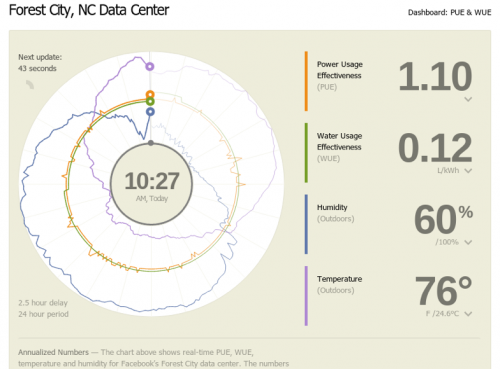[caption id="attachment_9257" align="aligncenter" width="500"]

Facebook's new dashboards for monitoring its data centers' power and water use.[/caption] Facebook has added real-time dashboards for measuring the efficiency of its data centers' internal power and water use, the company announced April 18. Two dashboards monitor the company's Prineville, Ore. and Forest City, N.C. data centers, measuring both the Power Usage Effectiveness (PUE) and Water Usage Effectiveness of those facilities, in addition to the ambient temperature and humidity. (Facebook pages for the
Prineville and
Forest City facilities are available, while the respective dashboards can be viewed
here and
here.) Although Facebook said it provided the information out of a sense of openness, the data—showing PUEs of about 1.09 for both facilities as of press time—is a bit of a boast, as well; as recently as 2011, Uptime Institute said that the average data center's PUE was approximately 1.8. Facebook's publication of the data is in keeping with its informal mission of sharing. (Remember, this is the same company that founded the Open Compute Project, a program to share datacenter data, including how to build “open” servers via a common design.) "Why are we doing this?" Lyrica McTiernan, a program manager for Facebook's sustainability team, wrote in a blog post provided to Slashdot in advance of the announcement. "Well, we’re proud of our data center efficiency, and we think it’s important to demystify data centers and share more about what our operations really look like. Through the
Open Compute Project (OCP), we’ve shared the building and hardware designs for our data centers. These dashboards are the natural next step, since they answer the question, 'What really happens when those servers are installed and the power’s turned on?'” So far, visitors to the Prineville and Forest City dashboards only see a limited snapshot of the Facebook data: the display only covers 24 hours, and is delayed by 2.5 hours on both sites. Facebook also hasn't disclosed how many servers the data represents, which could conceivably be used by competitors to get a sense of the social network’s total computing power. The company said that once its data center in
Luleå, Sweden, comes online, Facebook will begin adding data from that location, as well. Facebook cautioned that users shouldn't read too much into any blips or hiccups in the data, as both the Prineville and Forest City facilities are under construction, with new data halls coming online at various times. "As our data centers near completion and our load evens out, we expect these inevitable fluctuations to correspondingly decrease," McTiernan wrote. Facebook worked with a company called Area17 to design the visualizations. The two plan to open-source the code for the dashboards, placing it on the Open Compute Project’s GitHub repository in the coming weeks. Other datacenter operators will then be able to use the code and share the PUE, WUE, temperature, and humidity at their datacenter sites, connecting their own CSV files to do so. So far, Facebook hasn't said whether it will provide access to the dashboards via an API, so third parties can get a better sense of how Facebook is managing power and water use over time, and through various seasons of the year. For now, however, Facebook has provided an intriguing tool that will undoubtedly be used as a yardstick for others in the industry. [caption id="attachment_9256" align="aligncenter" width="520"]

Facebook's Prineville, Oregon facility.[/caption]
Images: Facebook  Facebook's new dashboards for monitoring its data centers' power and water use.[/caption] Facebook has added real-time dashboards for measuring the efficiency of its data centers' internal power and water use, the company announced April 18. Two dashboards monitor the company's Prineville, Ore. and Forest City, N.C. data centers, measuring both the Power Usage Effectiveness (PUE) and Water Usage Effectiveness of those facilities, in addition to the ambient temperature and humidity. (Facebook pages for the Prineville and Forest City facilities are available, while the respective dashboards can be viewed here and here.) Although Facebook said it provided the information out of a sense of openness, the data—showing PUEs of about 1.09 for both facilities as of press time—is a bit of a boast, as well; as recently as 2011, Uptime Institute said that the average data center's PUE was approximately 1.8. Facebook's publication of the data is in keeping with its informal mission of sharing. (Remember, this is the same company that founded the Open Compute Project, a program to share datacenter data, including how to build “open” servers via a common design.) "Why are we doing this?" Lyrica McTiernan, a program manager for Facebook's sustainability team, wrote in a blog post provided to Slashdot in advance of the announcement. "Well, we’re proud of our data center efficiency, and we think it’s important to demystify data centers and share more about what our operations really look like. Through the Open Compute Project (OCP), we’ve shared the building and hardware designs for our data centers. These dashboards are the natural next step, since they answer the question, 'What really happens when those servers are installed and the power’s turned on?'” So far, visitors to the Prineville and Forest City dashboards only see a limited snapshot of the Facebook data: the display only covers 24 hours, and is delayed by 2.5 hours on both sites. Facebook also hasn't disclosed how many servers the data represents, which could conceivably be used by competitors to get a sense of the social network’s total computing power. The company said that once its data center in Luleå, Sweden, comes online, Facebook will begin adding data from that location, as well. Facebook cautioned that users shouldn't read too much into any blips or hiccups in the data, as both the Prineville and Forest City facilities are under construction, with new data halls coming online at various times. "As our data centers near completion and our load evens out, we expect these inevitable fluctuations to correspondingly decrease," McTiernan wrote. Facebook worked with a company called Area17 to design the visualizations. The two plan to open-source the code for the dashboards, placing it on the Open Compute Project’s GitHub repository in the coming weeks. Other datacenter operators will then be able to use the code and share the PUE, WUE, temperature, and humidity at their datacenter sites, connecting their own CSV files to do so. So far, Facebook hasn't said whether it will provide access to the dashboards via an API, so third parties can get a better sense of how Facebook is managing power and water use over time, and through various seasons of the year. For now, however, Facebook has provided an intriguing tool that will undoubtedly be used as a yardstick for others in the industry. [caption id="attachment_9256" align="aligncenter" width="520"]
Facebook's new dashboards for monitoring its data centers' power and water use.[/caption] Facebook has added real-time dashboards for measuring the efficiency of its data centers' internal power and water use, the company announced April 18. Two dashboards monitor the company's Prineville, Ore. and Forest City, N.C. data centers, measuring both the Power Usage Effectiveness (PUE) and Water Usage Effectiveness of those facilities, in addition to the ambient temperature and humidity. (Facebook pages for the Prineville and Forest City facilities are available, while the respective dashboards can be viewed here and here.) Although Facebook said it provided the information out of a sense of openness, the data—showing PUEs of about 1.09 for both facilities as of press time—is a bit of a boast, as well; as recently as 2011, Uptime Institute said that the average data center's PUE was approximately 1.8. Facebook's publication of the data is in keeping with its informal mission of sharing. (Remember, this is the same company that founded the Open Compute Project, a program to share datacenter data, including how to build “open” servers via a common design.) "Why are we doing this?" Lyrica McTiernan, a program manager for Facebook's sustainability team, wrote in a blog post provided to Slashdot in advance of the announcement. "Well, we’re proud of our data center efficiency, and we think it’s important to demystify data centers and share more about what our operations really look like. Through the Open Compute Project (OCP), we’ve shared the building and hardware designs for our data centers. These dashboards are the natural next step, since they answer the question, 'What really happens when those servers are installed and the power’s turned on?'” So far, visitors to the Prineville and Forest City dashboards only see a limited snapshot of the Facebook data: the display only covers 24 hours, and is delayed by 2.5 hours on both sites. Facebook also hasn't disclosed how many servers the data represents, which could conceivably be used by competitors to get a sense of the social network’s total computing power. The company said that once its data center in Luleå, Sweden, comes online, Facebook will begin adding data from that location, as well. Facebook cautioned that users shouldn't read too much into any blips or hiccups in the data, as both the Prineville and Forest City facilities are under construction, with new data halls coming online at various times. "As our data centers near completion and our load evens out, we expect these inevitable fluctuations to correspondingly decrease," McTiernan wrote. Facebook worked with a company called Area17 to design the visualizations. The two plan to open-source the code for the dashboards, placing it on the Open Compute Project’s GitHub repository in the coming weeks. Other datacenter operators will then be able to use the code and share the PUE, WUE, temperature, and humidity at their datacenter sites, connecting their own CSV files to do so. So far, Facebook hasn't said whether it will provide access to the dashboards via an API, so third parties can get a better sense of how Facebook is managing power and water use over time, and through various seasons of the year. For now, however, Facebook has provided an intriguing tool that will undoubtedly be used as a yardstick for others in the industry. [caption id="attachment_9256" align="aligncenter" width="520"]  Facebook's Prineville, Oregon facility.[/caption] Images: Facebook
Facebook's Prineville, Oregon facility.[/caption] Images: Facebook 